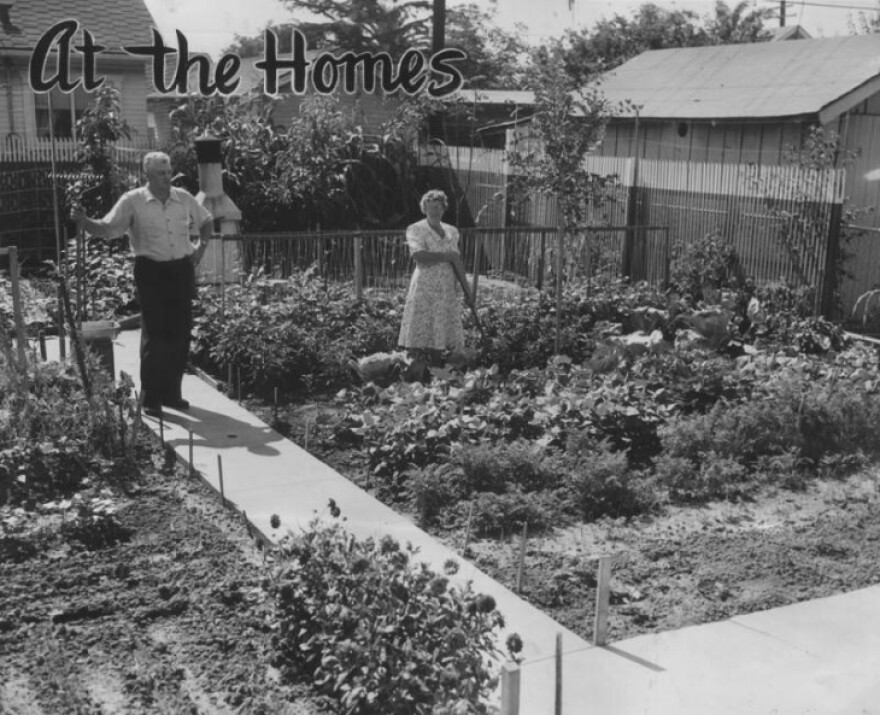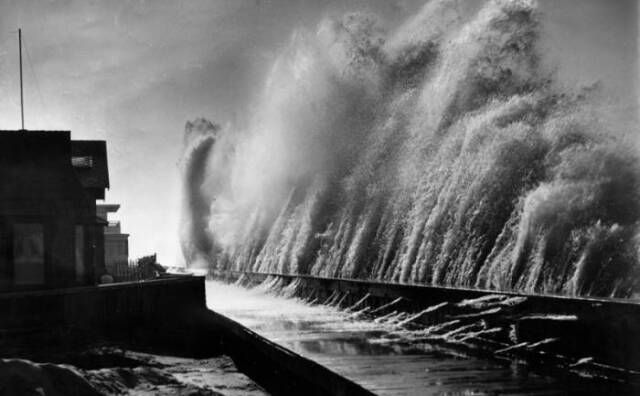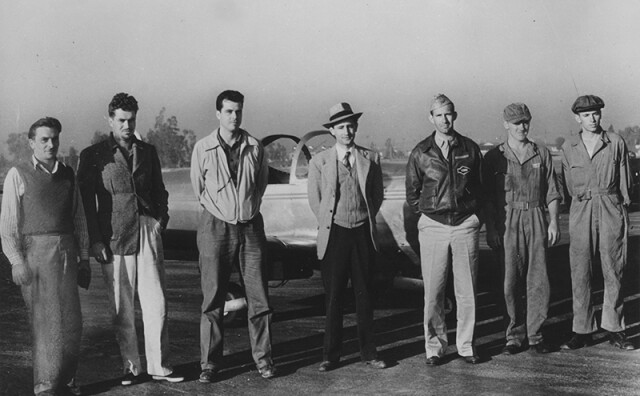How LA's Victory Gardens Helped Win WWII

"Today I ate some freedom peas, in my war garden grown; I often gather greens like these and boil them with a bone; and though the pears were small in size, in taste like castor oil, I viewed them with admiring eyes, the product of my toil. With pride the local voter eats his home-grown garden sass, his luscious Patrick Henry beets and sweet boon sparrowgrass, his taters may be small as beads, his lettuce coarse and tough, but joyously he on them feeds and cannot get enough." -Walter Mason, 1918
During the summer of 1943, Redondo Beach resident Chester F. Lancaster could be found on most days in his celebrated victory garden, cultivating vegetables and fruit. Blinded in World War I, Lancaster spent World War II as a "soldier of the soil" growing his garden to aid the war effort.

"With the exception of actual planting, Lancaster takes care of the cultivation of his entire garden, working with his sensitive fingers among the growing plants and harvesting their produce. Records of the yield of his plot show an ample supply for his family and a plentiful surplus for canning and dehydration," the Los Angeles Times reported.

Lancaster wasn't the only Angeleno who developed a green thumb during WWII. Across Los Angeles County, thousands of residents grew their own produce during World War II, joining a nationwide effort. The victory garden movement was so successful that, according to historian Sam Gnerre, by 1943 around 20 million victory gardens had been planted, and they were supplying 40% of the produce in the United States.
The war garden movement originated in England during World War I, under the auspices of the Women's Land Army. When the U.S. entered the war in 1917, lumber heir Charles Lathrop Pack was named the head of the National War Garden Commission. Botanist and L.A. pioneer Luther Burbank joined him on the commission, which aimed to teach Americans to grow their own produce, so farmed food could go to soldiers and allies overseas.
As Pack noted in Garden Victorious: History of the War Garden (Victory Garden) During WW I:
"The war-garden idea struck a patriotic chord. The American people answered the call to help win the war by producing food in their back yards with the same unanimity and enthusiasm they had shown in responding to each other appeal the country had made for service. One reason for the prompt and eager response to the National War Garden Commission's appeal to "Sow the Seeds of Victory" was that immediately after the United States entered the war everybody was patriotically desirous of rendering help in some form."

In Southern California, temperate weather meant residents could grow produce year-round and they had few excuses to not try. They were aided by instructional manuals, seed catalogues and booklets distributed by the U.S. government.
By Jan. 1, 1918, communities like Santa Monica reported on their growing garden movements in the Los Angeles Times:
"The community launched itself with enthusiasm into the home garden movement, with the result that no less than 300 lots were put under cultivation and more than 17,000 worth of foodstuffs raised in addition to the usual production. Even the high school students did their share by putting under cultivation ten acres of leased land, planting it to beans...the high school students in November began the planting of home gardens, and through this winter an acre of cauliflower, beets, and other vegetables are being grown on the school grounds..."

Santa Monica residents were so enthusiastic they asked the city for permission to plant in the green spaces between the street and the sidewalk.
"This was done by many, with the result that approximately 50 more acres were put under cultivation and the city was treated to the sight of tall cornstalks or meandering vines of the pumpkin or watermelon variety in the place of the neat grass plots that heretofore adorned the park strips," the L.A. Times reported.

In Hollywood, the firemen in Engine Company No. 27 at Cahuenga and Selma planted a mini-farm in the empty acre-and-a-half lot next to their station.
"Last year the men raised 300 pounds of beans and over 2,200 pounds of onions, most of which were given to the National Guard camp," the L.A. Times reported in March 1918. "The men have constructed a large size cultivator, to which several hitch themselves at a time, horse fashion. By this means, the rows of vegetables can be planted more closely together and much valuable space conserved... in addition to supplying their own needs, it has been the custom of the firemen to send baskets of vegetables to various poor families."
L.A. school children also got in on the act, as part of the Federal Bureau of Education's United States School Garden Army. According to the Smithsonian Libraries, by 1919, 2.5 million children were gardening school plots, producing $48 million worth of food.
In July of 1918, Dr. Van Evrie Kilpartick, considered the "father of the school garden movement," toured school gardens around L.A. He was impressed and told the L.A. Times:
"I visited gardens aggregating hundreds of acres and all showing evidence of the greatest care and fruitfulness. The most striking thing to me is that gardening in the public schools of Los Angeles, the fame of which has become nation-wide, has contributed as a background to the whole civic movement toward food gardens...I visited a great number of splendid school gardens. These are not only among the most beautiful I have ever seen in the United States or Canada, but they show evidence of organization and support."
According to Pack, by 1918 there were a staggering 5,285,000 war gardens throughout the country. However, not everything went smoothly. In 1917, two next door neighbors on Fountain Avenue in Los Feliz got in a fight when a chicken escaped from one's garden into the others. "The way for the final attack was cleared when Miss Lamereaux asked for the carcass of the chicken. It was testified Mrs. Kruger complied by using the dead fowl after the manner of a hand grenade, and pressed home her advantage by striking Mrs. Lamereaux on the head with the hoe," the L.A. Times reported.

There were also unforeseen predators eager to eat the bounty tended by "soldiers of the soil." A Santa Monica Holstein cow named Gretchen was accused of eating vegetables and trampling them underfoot. She was held at the city pound until her owner repaid the damages.
It was not until the end of World War I that Pack coined the phrase "Victory Garden." The term would pick up steam in early 1942, after the U.S. entered World War II following the attack on Pearl Harbor.
In early 1942, the National Victory Garden Conference convened in Washington, D.C. Despite the success these gardens had seen during WWI, leaders were dismissive of the previous war garden movement, claiming it had been disorganized and that the gardens had been inefficient and amateurish.

They began to organize a nationwide victory garden apparatus, with field offices in each region. Potential gardeners were encouraged to only plant what was needed -- 30 by 50 feet would do for a family of four -- and one hour a day would be needed for maintenance.
"Vegetables for victory (remember -- a poor war garden helps the Axis)! This spring will see more vegetable gardens than any year since the first World War. Millions of people will make this contribution to victory. Their effort will take a load off an already overburdened transport system. It will release canning capacity and allow more food to flow to our allies," the L.A. Times wrote.
In Southern California, the movement was spearheaded by horticulturalist Gordon Baker Lloyd, victory garden coordinator for the region. L.A. mayor Fletcher Bowron proclaimed the week of April 11, "Victory Garden Planting Week." Water companies offered reduced utility rates to local planters and the government provided its own formula for fertilizer.

Newspapers became a vital resource for Angelenos attempting to plant their gardens. The L.A. Times sponsored the Times Victory Club, which distributed a free magazine, "Victory Garden Times," offered training, and even a patriotic window emblem. The club built a model garden planted by Baker Lloyd at Stanley and Wilshire Blvd. and eventually established a garden center at 2234 Adams Blvd. Lloyd and other instructors taught gardening classes to the public twice a week, free of charge, in conjunction with the Board of Education.
L.A. County Deputy Agricultural Commissioner Howard Wilcomb also had a weekly Times column, "Victory Garden Pest Control," where he dished out advice including the use of nicotine dust sprays on vulnerable tomatoes. Baker Lloyd and others wrote detailed instructional articles illustrating how to plant several different models of Victory Garden. The instructions for Victory Garden #6 read:
"Plant three rows of white seeded Kentucky wonder string beans, one row early wonder table beets, 2 rows romaine lettuce, 2 rows swiss chard, one row white bush scallop summer squash... 3 rows tomatoes, 1 row Earliana variety and 2 rows beefsteak variety."

No edible plant got as much attention as the tomato.
-
We're here to help get your outdoor space looking great with practical tips, news and what you need to do to keep conservation in mind.
"No vegetable has a more important place in the victory garden program than this triple threat vegetable. For fresh salads, for cooking and for canning either solid pack, as juice or sauce, the tomato can contribute more to the family food supply than any other easily grown vegetables... most any of our soils here in southern California will produce a pretty good crop of tomatoes," the L.A. Times said.
With the advent of strict rationing, animals also became part of the victory garden movement.
"With the shortage of our favorite kinds of meat daily becoming more acute, resourceful southern Californians are adding a few chickens or rabbits to the backyard victory garden scene. Squabs, too, are being included in the domestic food production line as prudent householders look around for suitable meat replacements," SoCal cooking instructor Marian Manners wrote.
Popular L.A. columnist Lee Shippey, tiller of his own garden, was a fan of raising chickens. "Every time you weed the garden you have a banquet for the chicken, and every time you clean the henhouse you have fertilizer for 100 square feet of garden, in which luscious new weeds will spring up overnight," he said.

Thousands of Angelenos who lived in apartments and townhomes found ingenious ways to grow their own food. Patios were stacked with ornamental terra cotta jars sold around Olvera Street and planted with strawberries. Angelenos installed trellises on balconies, perfect for cultivating cucumbers, beans, peas and tomatoes.
Those without their own yard also banded together to grow food in community gardens. "Many groups of gardeners have joined forces to further a movement by which empty lots previously given over to realtor's signs, weeds and nondescript rubbish may have a hand in winning the war," the L.A. Times reported.
One such community garden, said to be the largest victory garden in the country, was planted by local Mormons on 31 previously empty acres in the East L.A. neighborhood of Belvedere Gardens. Leased by Leo Marks, war gardens director for East Los Angeles, the land was cultivated by three local Mormon temples and a nearby defense plant. According to the Daily Breeze, 50 acres of Alondra Park were cultivated by the L.A. County Board of Supervisors to plant enough food to make up for the Japanese American farmers in L.A. County who had been interred in relocation camps.
Having a Victory Garden soon became a point of pride and status symbol for Angelenos. Mrs. A.S. McHenry, owner of the Tail O' the Cock on La Cienega Boulevard, turned the restaurant's circular fireplace into a mini victory garden with little rows of radishes and lettuce. One local columnist grew garlic and parsley in a prominent zinc box placed under a picture window in his living room. Women were encouraged to wear a "trim little cotton shirtwaist dress" when gardening. Even L.A.'s high society made a point to display their patriotic Victory Gardens. In 1942, the Times reported:
"The Julien Dows' buffet supper the other evening was, in a way, a preview of not only their new home, but that much talked about Victory Garden of Julien's. This little plot of ground must have been laid out by a surveyor. Each carrot and each head of lettuce is in order to obtain a perfectly balanced effect. You almost hated to pick them- yet some of the guests did, washing them off under the garden spigot and eating them on the spot."

According to Sam Gnerre, more than 200,000 acres of victory gardens were planted in Los Angeles County during 1943. As rations increased, limiting Angelenos' red meat-centric diets, food columnists served up recipes for deviled chicken, rabbit in wine and broiled squab. Dinners featuring veggie-based main courses also became common.
"One smart homemaker follows a routine of spinach on Monday, carrots on Tuesday, eggplant on Wednesday, and so on. She has a wondrous file of inspiring recipes gleaned from everywhere to give vegetable dishes a 'surprise' interest and the family has made a sort of game of it," Food columnist Marian Manners wrote.
"Let one vegetable play the part of the piece de resistance, the other supplementing it. For example, peppers stuffed with corn, creamed diced turnips, spinach with almonds sautéed in margarine, hashed Harvard beets make a nutritious dinner plate as attractive as it is satisfying... walnut potato fluff, vegetable casserole... mashed potatoes in a mold and filled with peas and garnished with cooked carrots and cauliflower."

Canning excess veggies and fruit also became a necessity for home gardeners. "Peas come in successive waves. Once you've had your fill of them at table, you'll be spending what seems almost interminable hours shelling and processing the surplus in jars," Vogue Magazine said.
Victory gardens even inspired local poets. In May 1943, L.A. Times writer Bill Henry wrote a little ditty that read in part:
I have a lovely Victory Garden,
And praise it surely merits;
It is a jewel, sure enough,
Because of its fourteen carrots.
Victory gardens would be credited with helping win the war by getting food to soldiers overseas and feeding hungry Americans at home. But with the Allied Victory in 1945, and the loosening of rationing soon after, many Angelenos — and Americans — let their home gardens go to pot. The late 1940s and '50s would be the era of pre-packaged TV dinners, processed food and Jell-O, with fresh vegetables losing out to frozen, store-bought ones.
-
Restored with care, the 120-year-old movie theater is now ready for its closeup.
-
Councilmember Traci Park, who introduced the motion, said if the council failed to act on Friday, the home could be lost as early as the afternoon.
-
Hurricane Hilary is poised to dump several inches of rain on L.A. this weekend. It could also go down in history as the first tropical storm to make landfall here since 1939.
-
Shop owners got 30-day notices to vacate this week but said the new owners reached out to extend that another 30 days. This comes after its weekly swap meet permanently shut down earlier this month.
-
A local history about the extraordinary lives of a generation of female daredevils.
-
LAist's new podcast LA Made: Blood Sweat & Rockets explores the history of Pasadena's Jet Propulsion Lab, co-founder Jack Parsons' interest in the occult and the creepy local lore of Devil's Gate Dam.









